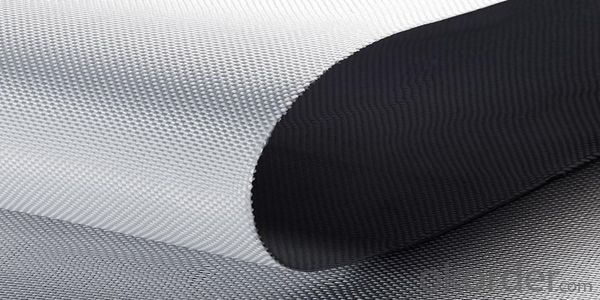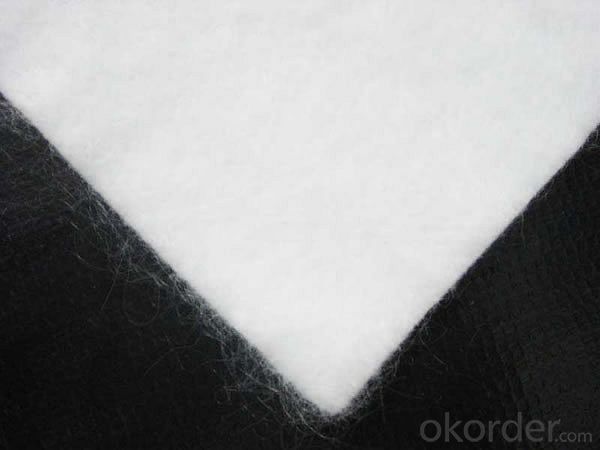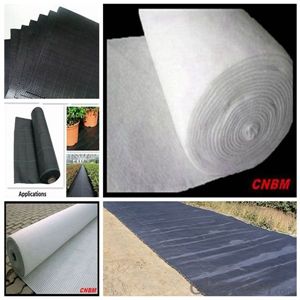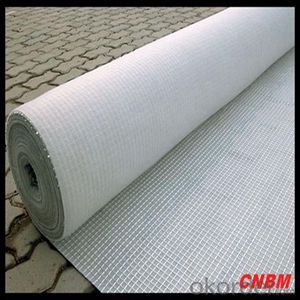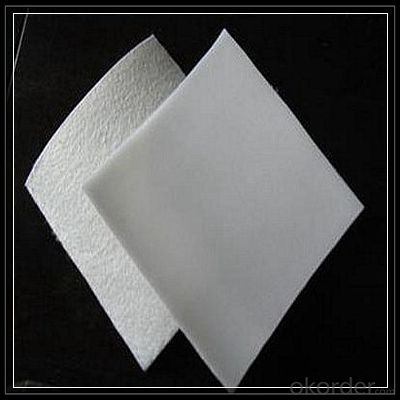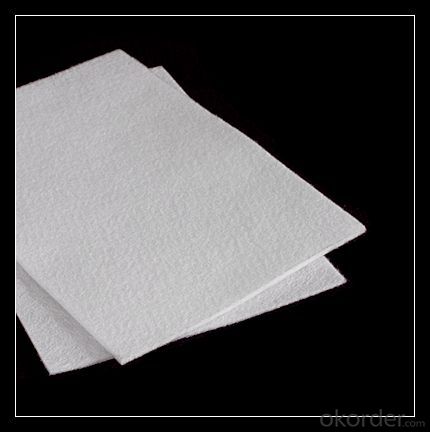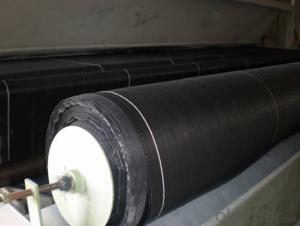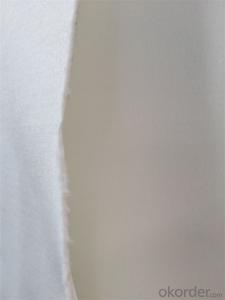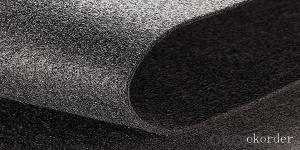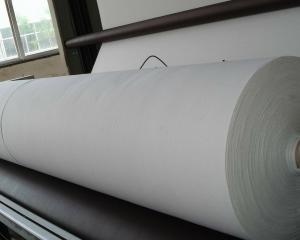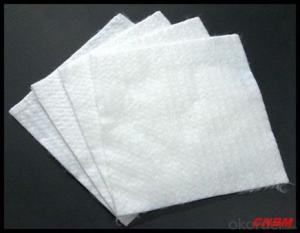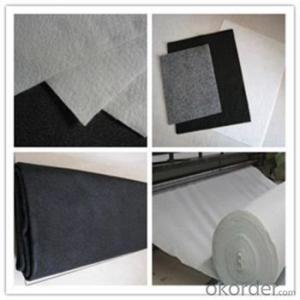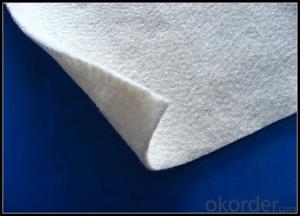Spunbond Non Woven Geotextiles Industrial Nonwoven fabric
- Loading Port:
- China main port
- Payment Terms:
- TT OR LC
- Min Order Qty:
- 1000 m²
- Supply Capability:
- 1000000 m²/month
OKorder Service Pledge
OKorder Financial Service
You Might Also Like
Specification

Product Introduction
Nonwoven geotextiles consist of fibers that are continuous filament or short staple fibers. These fibers are then Nonwoven geotextiles Image bonded together by various processes that can include a needling process that intertwines the fibers physically (needlepunched), or a chemical / thermal bonding operation that fuses adjacent fibers together. The resulting nonwoven geotextiles have a random fiber orientation with high porosity and permeability, but indirect and unpredictable openings, a thickness ranging from thick felt to a relatively thin fabric, and low modulus and high elongation (needlepunched).
Non Woven Geotextile Application:
(1) artificial filling foundation movement of ground water.
(2) gravel filter layer surrounding the periphery of the drain pipe drain.
(3) in water conservancy projects wells, relief wells or inclined pipe filter.
(4) for retaining wall backfill reinforcement, or for anchored retaining wall panel.
(5) reinforced flexible pavements, crack repair roads, prevent the reflection cracks of pavement.
(6) in ternal vertical or horizontal drainage, dissipation of pore water pressure in soil.
(7) water impermeable geomembrane dam or embankment in the lower part of the back or the concrete.
(8) the isolation layer between the road ballast and subgrade, isolation layer or between the embankment and soft foundation.
(9) the isolation layer soil between highway, airport, railway ballast and artificial rockfill and soil fabric.
Our Service
Quality assurance
1.On a regular basis or as per your request,we entrust national testing agencies to conduct quality inspections
2. Strictly in accordance with the ISO9001-2008 international quality system standard,we monitor and manage the whole process throughout production,quality testing,and measurement to ensure product quality
3. For quality-related construction delay or substandard construction(except for damage or losses due to customer’s responsibility or irresistible natural disasters),we have refunding,replacement,and repair services.We will respond to customers’ feedbacks on quality issues within 24 hours.
Packaging & Shipping
Packing: PLASTIC FILM INSIDE, AND WOVEN BAG OUTSIDE
Shipping: About 15 days after receipt the deposit
FAQ:
Q: What kind of payments does jenor support?
A: T/T, L/C, Cash are accepted.
Q: Do you charge for the samples?
A: Accordeing to our company policy, the samples are free, we only charge the freight fee. And we will return the freight fee during the next order.
Q: Can you produce according to customers' design?
A: Sure, we are professional manufacturer, OEM and ODM are both welcome.
Q: Do you have other products?
A: Yes, please check the pictures:
- Q: Can geotextiles be used in land reclamation projects?
- Yes, geotextiles can be used in land reclamation projects. They are often utilized for erosion control, soil stabilization, and drainage purposes in these projects. Geotextiles help to prevent soil erosion and provide a stable base for vegetation growth, making them a valuable tool in land reclamation efforts.
- Q: Can geotextiles be used in geocomposite applications?
- Yes, geotextiles can be used in geocomposite applications. Geocomposites are materials made by combining different geosynthetic components, including geotextiles, to achieve specific engineering functions. Geotextiles, due to their high tensile strength, filtration capabilities, and drainage properties, are commonly used in geocomposites to enhance the overall performance and functionality of the composite material.
- Q: Can geotextiles be used for reinforcement of railway embankments?
- Yes, geotextiles can be used for reinforcement of railway embankments. Geotextiles are commonly used in civil engineering projects for their ability to provide separation, filtration, and reinforcement functions. When used in railway embankments, geotextiles help improve the stability and strength of the embankment by preventing the mixing of different soil layers, reducing soil erosion, and distributing load more evenly. Overall, geotextiles are an effective solution for reinforcing railway embankments and enhancing their long-term performance.
- Q: Supply Tianhe District staple geotextile and anti-geotextile what is the same
- Staple geotextile is made of polyester staple fiber by acupuncture, because it can play the role of anti-filtration, and thus staple geotextile can also be called anti-geotextile. Filter geotextile is based on the use of the name, so long as it is able to play the role of anti-filter geotextile called geotextile filter, geotextile, including geotextile geotextile, filament geotextile, the preparation of geotextile, Woven geotextile, non-woven geotextile, polypropylene geotextile. Tianhe District used staple geotextile and anti-filter geotextile is the same.
- Q: What are the factors to consider when specifying geotextiles?
- When specifying geotextiles, it is important to consider factors such as the type and purpose of the project, the desired functions of the geotextiles (filtration, separation, reinforcement, etc.), the site conditions, the expected loads and stresses, the required durability and longevity, the installation and maintenance requirements, and the cost-effectiveness of different geotextile options.
- Q: What are the installation techniques for geotextiles?
- There are several installation techniques for geotextiles, depending on the specific application and site conditions. Some common techniques include anchoring the geotextile with stakes or pins, securing it with sandbags or gravel, or using mechanical devices such as anchors or screws. The geotextile may also be overlapped and sewn together, or heat-welded to create a continuous barrier. It is important to follow the manufacturer's guidelines and industry standards when installing geotextiles to ensure proper functionality and longevity.
- Q: 800g / m2 non-woven geotextile vertical permeability coefficient is generally how much
- 800g / m2 non-woven geotextile vertical permeability coefficient is: 6.1 × 10-2
- Q: Can geotextiles be used for shoreline protection?
- Yes, geotextiles can be used for shoreline protection. They are commonly used to stabilize coastal areas and prevent erosion by acting as a barrier against wave action and water currents. Geotextiles help to retain sediment and provide structural support, making them an effective solution for shoreline protection projects.
- Q: Health geotextile how much money ah?
- Health geotextile, also known as geotextile, it is made of synthetic fibers through the needle or woven from the permeability of geosynthetics. Finished cloth for the cloth, the general width of 4-6 meters, the length of 50-100 meters. The price according to the weight and standard to set, weight (80-1500g / ㎡), the quality standard is a requirement, divided into non-standard, whitening A, Sinochem, the general national standard, Paul national standard, Wait. Ton price is generally between 4900-7500 yuan / ton, but the weight <200g, an increase of 100 yuan / ton; weight> 800g, an increase of 500 yuan / ton. 187 & lt; 6600 & lt; 5604
- Q: Road geotextile about how much money
- Road moisturizing health geotextile Price: 1.20 yuan to 2.40 yuan / square meter.
Send your message to us
Spunbond Non Woven Geotextiles Industrial Nonwoven fabric
- Loading Port:
- China main port
- Payment Terms:
- TT OR LC
- Min Order Qty:
- 1000 m²
- Supply Capability:
- 1000000 m²/month
OKorder Service Pledge
OKorder Financial Service
Similar products
Hot products
Hot Searches
Related keywords






